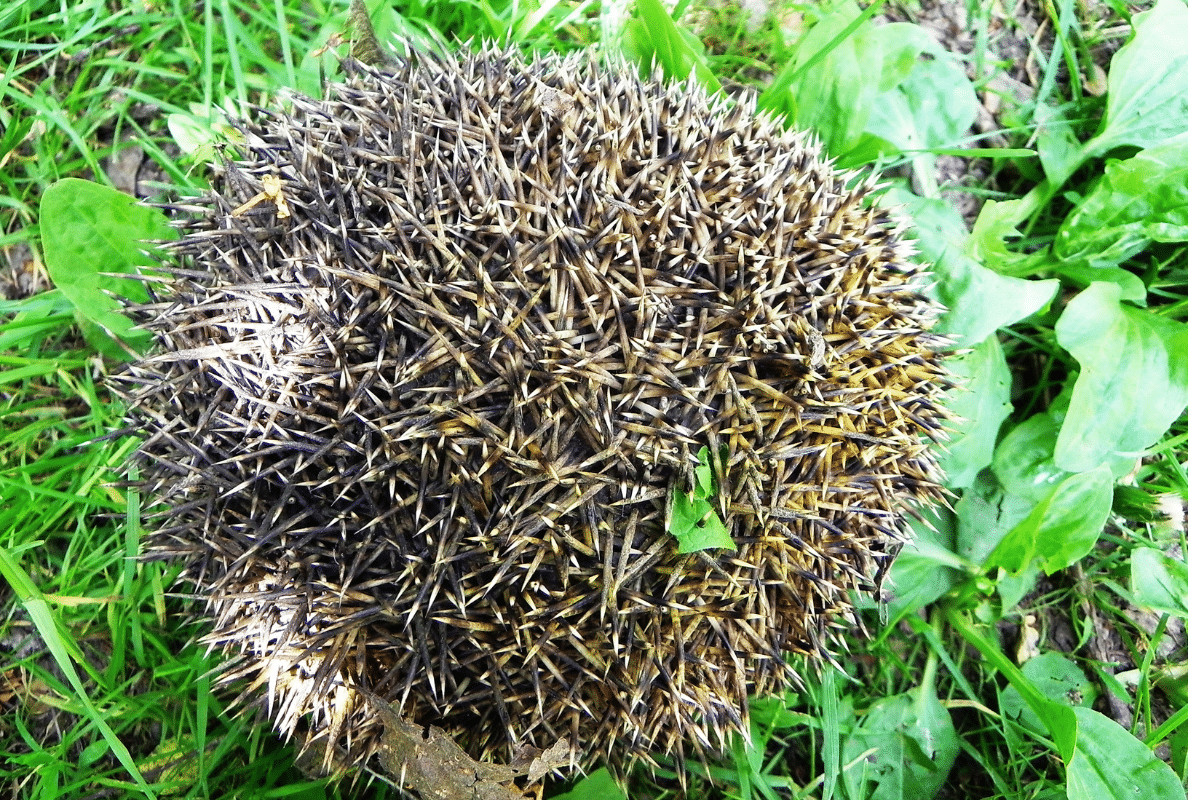Hedgehogs are the UK’s only native species of spiny mammal and their prickles are a unique and formidable defensive mechanism. But there’s more to hedgehog spines than just armour. From buoyancy aids to shock absorbers. There are a whole host of fascinating answers to the question of why do hedgehogs have spines!

The Anatomy of a Hedgehog Spine
Before we look at how hedgehogs use their prickles let’s take a closer look at one – they are pretty amazing things.
The Basic Material
Hedgehog spines and porcupine quills are both modified hairs, They are made from the same material as human hair – keratin.
Keratin is a fibrous protein. It’s very strong and as well as hair and spines it is the basic building blick for nails, claws, horns and spiders webs. Keratin doesn’t dissolve in water and it’s indigestible, Which is why cats spit up furballs and why fur and feather turn up in the poo of carnivorous animals.
Design and Build
Each of the hedgehog’s spines is a cunning piece of engineering, offing many benefits for the wearer.
The spines are about 2.5 to 3cm long, and about 2mm wide at the widest point. As we know, each prickle tapers to a very sharp end, but the end that goes into the skin tapers too and bends through 60 degrees before expanding into a ball which anchors the spine into the hedgehog’s skin, again much like human hair.

The sines are hollow with a very strong, ridged outer casing.
Baby hedgehogs first spines are white, and some hogs, known as leucistic hedgehogs, retain white spines throughout their lives. But for the majority of hogs, adult spines will have a white tip with bands of brown further down. This is what gives hedgehogs their distinctive grizzled or mottled appearance if you see one out in the daytime.

How Many?!?
An adult hedgehog will have around 7,000 spines. Pat Morris was one of the first hedgehog researchers to verify this figure. In his book Hedgehogs, he tells us he did this by cutting the spines off several dead hedgehogs and counting them!
I’m not sure whether to applaud his patience or tell him he needs to get out more.
Do Baby Hedgehogs Have Spines?
The thought of giving birth to a baby covered in sharp spines is enough to make anyone wince. But baby hedgehogs are born with spines.
Luckily the spines on a hoglet are each topped with a pimple and covered in loose skin at birth. Much more comfortable for Mum. These first sines emergy through the skin within hours of the hoglet being born. The baby hedgehog has around 100 spines to start with. They are white and arranged around a centre parting.
Some people assume baby hedgehogs have soft spines, this isn’t the case. Even the first crop of white spines are pretty sharp. And the young hedgehog has muscular control over them from a very early age and can bristle them to deter potential predators.
Do Hedgehogs Moult Their Spines?
Hedgehogs don’t naturally lose large amounts of spines at one time like some birds lose feathers each year. Instead, they gradually lose spines and grow new ones throughout their lives.
The exception to this is hoglets. Hoglets have two sets of “baby spine” which they will grow and lose before their mature spines establish. However, unlike humans with baby teeth, hedgehogs new spines spring up between the old juvenile ones and new spines are fully developed before old ones fall out.
Going bald isn’t a typical feature of hedgehog ageing, but stress or parasite infestation can cause hogs to drop a large number of spines at once, or even become completely bald. Spines can and will regrow as the hedgehog recovers.
Hedgehog Spines As a Defence Mechanism
One of the European hedgehog’s most iconic behaviours is its ability to curl itself into a spiky ball to defend itself from predators.
Though it is a prey animal, a fully curled hedgehog presents an unappetizing ball and its spiny protection is enough to put off most predators.
But how is the impressive defence mechanism achieved exactly?
Well to achieve its famous defensive position the hedgehog uses extra skin and no less than 3 distinct muscle groups.
On feeling nervous a hedgehog will first bristle its spines so that they point outwards. It will then contract a band of muscles around its back legs and tail, and another round its head to pull its spines down over its vulnerable areas.

Hedgehog watchers will recognise this as the “Fringe Down” position, often adopted by hedgehogs who are not entirely comfortable with their situation. Even in this pose, the hedgehog is pretty well protected. And the advantage of this position over the full ball is that the hedgehog is still mobile and can choose to make a run for it if that seems like the best course of action.
When the hedgehog feels threatened though they will fully roll up. This is achieved by tightening and band of muscles that runs right around the body where the spines meet the fur.
The muscles tighten like the drawstring on a bag, forcing the feet and head together and drawing the loose skin and spines around the whole lot in a protective coating.
No other species, except maybe the earwig, can form such a tight and secure defensive ball. And the best thing is that a hedgehog can stay that way comfortably for hours, waiting for a potential predator to just lose interest.

What Else Do Spines Do?
Though defence is undoubtedly the primary function of the hedgehog’s spines they do play an interesting part in some other situations.
Shock Absorbers
Not only do hedgehogs spines protect them from the claws and jaws of predators they offer immense protection from blows and falls too.
The narrow neck of each spine can flex and bend when pressure is applied to the tip. And the bulbous root of the spine prevents it from being pushed into the hedgehogs’ flesh.
Scientists calculate that a hedgehog’s spines mean that it can survive blows and impacts of 200 times the force that would crush it without its prickly coat.
There is speculation that it may be the hedgehog’s awareness of its bouncy coating that makes it so laid back about launching itself off things when it has no idea how far it might fall.
Buoyancy Aid
I know the defence mechanism is the most important function of a hedgehogs spines – but I think this is the coolest!
Because a hedgehog’s prickles are hollow when the hog is swimming they can act as a buoyancy aid. The hedgehog can float on its back, just as though it has its own personal, built-in lilo. Look!
Hedgehogs can roll up and float like a boat
These are African pygmy hedgehogs, but our own European hedgehog has just the same amazing ability.
Prickly Problems
Whilst hedgehogs spines offer many advantages they have some serious drawbacks too.
Not Very Cosy
The first of these is probably their poor insulation ability. Whilst many of our native mammals, like the fox and badger, are covered in dense fur which does a great job of keeping them warm in the winter, hedgehog spines are pretty useless as insulation.
The hedgehogs’ prickles are hollow and very widely spaced, so they do a very poor job of trapping a blanket of warm air around the hog’s body. The hair on a hedgehog’s face, legs and underside is also pretty coarse and thin, not great for keeping the weather out.
This may be all well and good for desert hedgehogs, but for our own European hedgehog maybe this poor insulation is one of the reasons why hibernation is the best coping strategy for the winter months.
Pinned in Place
Spines are also a big contributory factor to the hedgehog’s ability to get stuck in all sorts of difficult and dangerous situations.
A hedgehog can flatten his spines to crawl into a tight space. If he can keep crawling straight out the other side he will be fine. But if the hog is forced to reverse out of whatever he’s wedged himself into then he will be in trouble and the spines are likely to catch and keep him pinned in place.
This is one of the reasons garden netting can be such a hazard for hedgehogs.
Quills v Spines
If you think a hedgehog’s spines are vicious take a look at the porcupine.
Many people think that because not many animals have spines and both hedgehogs and porcupines are spiny mammals they must be related. In fact, they are totally different species that have evolved completely separately.
And although hedgehog spines and porcupine spines, usually called quills might look superficially similar, they could hardly be more different.
Whilst a baby hedgehog’s spines are small but sharp a porcupette is born with soft quills which gradually harden with age.
Hedgehogs spines are used purely defensively – they will give a nasty jab to anyone who tries to penetrate the balled up hog.
The porcupine on the other hand will raise and shake its quills at a predator in a frightening aggressive display.
And whilst hedgehog spines are firmly routed (apparently you could pick up a hedgehog by one spine, but please don’t try this at home) porcupine quills come out easily, embedding themselves in an attacker and often snapping and leaving painful bits to work their way into a predators flesh.
Add to this the fact that porcupine spines can grow up to 20 inches long, and one animal can have 30,000 of them, and I’m very glad that the hedgehog is our only spiny mammal here in the UK!
Thanks For Reading
Hopefully, we’ve given you a bit of an insight into what an amazing adaption hedgehog spines are. It would be truly tragic if we were to lose such a unique and amazing creature from our lives. So all the more reason to do everything we can to help our wild hedgehogs.
Do you have questions, stories or suggestions? We would love to hear them. Leave us a comment below.

















are european hedgehos he only ones to roll into a ball?